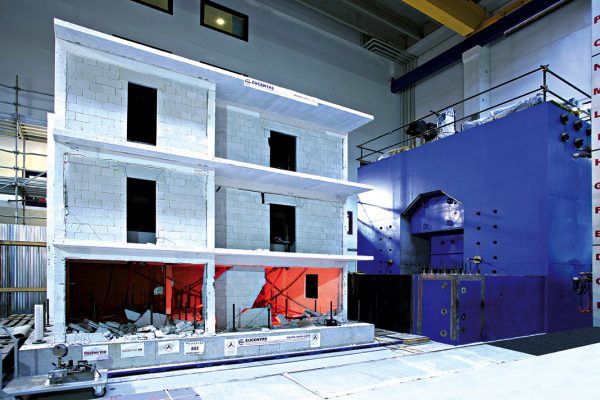Nel campo dell’ingegneria sismica, la capacità di simulare con precisione il comportamento strutturale durante eventi estremi è fondamentale per innovare la progettazione e garantire la sicurezza. In questo contesto si inserisce il Bearing Test System (BTS), un’infrastruttura sperimentale avanzata, sviluppata e operativa presso i laboratori della Fondazione Eucentre a Pavia.
Cos’è il Bearing Test System?
Il BTS è un sistema di prova multifunzionale progettato per effettuare test su dispositivi di isolamento e dissipazione sismica in scala reale. La sua peculiarità risiede nella capacità di applicare carichi statici e dinamici con 5 gradi di libertà controllati: traslazioni verticali e longitudinali, oltre a rotazioni roll, pitch e yaw. Inoltre, una configurazione opzionale consente di estendere i gradi di libertà a 6, permettendo movimenti tridimensionali completi.
Specifiche tecniche
- Carico verticale statico massimo: 40.000 kN
- Carico verticale dinamico aggiuntivo: 10.000 kN
- Forza orizzontale massima: 2.000 kN (fino a 2.800 kN in configurazione alternativa)
- Spostamento orizzontale massimo: ±480 mm
- Dimensioni della tavola di base: 1,7 m x 4,3 m
- Sistema di controllo: digitale in tempo reale, con controllo PID e feedback delta-P
Obiettivi e applicazioni
Il BTS è stato concepito per:
- Validare modelli numerici utilizzati nella previsione della risposta sismica
- Testare dispositivi innovativi di isolamento e dissipazione, come isolatori elastomerici, isolatori a scorrimento su superficie curva e dissipatori viscosi
- Supportare lo sviluppo di normative tecniche, attraverso dati sperimentali di alta qualità
Le applicazioni spaziano dalle prove su giunti strutturali a quelle su elementi prefabbricati, fino a test su dispositivi avanzati di protezione sismica.
Un’infrastruttura sperimentale all’avanguardia
Il BTS fa parte dei laboratori sperimentali della Fondazione Eucentre, che includono anche tavole vibranti ad alte prestazioni, sistemi di prova dinamica e strumenti di acquisizione avanzata. Queste infrastrutture permettono test su larga scala in condizioni molto prossime a quelle reali, contribuendo alla riduzione delle incertezze progettuali e all’aumento della resilienza strutturale.
Collaborazioni internazionali
Eucentre grazie all’utilizzo del BTS ha partecipato a progetti europei come SERA (Seismology and Earthquake Engineering Research Infrastructure Alliance for Europe), che promuoveva l’accesso transnazionale a infrastrutture sperimentali di eccellenza. e collabora anche con NHERI (Natural Hazards Engineering Research Infrastructure) negli Stati Uniti, consolidando il suo ruolo nella ricerca sismica internazionale.
Grazie alla presenza del Bearing Test System tra le sue infrastrutture di prova, la Fondazione Eucentre si conferma leader nella sperimentazione scientifica applicata all’ingegneria sismica. Un’infrastruttura che rappresenta un riferimento europeo per lo studio di dispositivi innovativi e per il miglioramento continuo della sicurezza strutturale.
 Eucentre è una Fondazione di diritto privato senza scopo di lucro che persegue una missione di ricerca, formazione e erogazione di servizi nel settore dell’ingegneria sismica e, più in generale, dell’ingegneria della sicurezza
Eucentre è una Fondazione di diritto privato senza scopo di lucro che persegue una missione di ricerca, formazione e erogazione di servizi nel settore dell’ingegneria sismica e, più in generale, dell’ingegneria della sicurezza  Eucentre promuove Scienza, Ricerca e Innovazione a beneficio della collettività, offrendo metodologie mirate e soluzioni concrete per prevenzione, sicurezza e resilienza. Collabora con istituzioni e imprese, diffondendo competenze orientate al vantaggio comune.
Eucentre promuove Scienza, Ricerca e Innovazione a beneficio della collettività, offrendo metodologie mirate e soluzioni concrete per prevenzione, sicurezza e resilienza. Collabora con istituzioni e imprese, diffondendo competenze orientate al vantaggio comune. Tavole vibranti
Tavole vibranti Altri sistemi di prova
Altri sistemi di prova Eucentre conduce attività di ricerca su ingegneria sismica e riduzione del rischio, attraverso prove di laboratorio e analisi numeriche, per migliorare il comportamento sismico di strutture e terreni e sviluppare tecniche innovative di consolidamento antisismico.
Eucentre conduce attività di ricerca su ingegneria sismica e riduzione del rischio, attraverso prove di laboratorio e analisi numeriche, per migliorare il comportamento sismico di strutture e terreni e sviluppare tecniche innovative di consolidamento antisismico. La Fondazione promuove attività formative diversificate e di alta qualità, rivolte a contesti accademici e professionali, con programmi e iniziative costantemente aggiornati e innovativi per rispondere alle esigenze in continua evoluzione del settore e della società
La Fondazione promuove attività formative diversificate e di alta qualità, rivolte a contesti accademici e professionali, con programmi e iniziative costantemente aggiornati e innovativi per rispondere alle esigenze in continua evoluzione del settore e della società  Eucentre assicura una comunicazione per informare istituzioni, professionisti e cittadini sulle attività e i progetti in corso, con l’obiettivo di diffondere contenuti e conoscenze utili e accessibili a tutti. Contribuisce a promuovere una cultura della prevenzione e della resilienza, condivisa e consapevole.
Eucentre assicura una comunicazione per informare istituzioni, professionisti e cittadini sulle attività e i progetti in corso, con l’obiettivo di diffondere contenuti e conoscenze utili e accessibili a tutti. Contribuisce a promuovere una cultura della prevenzione e della resilienza, condivisa e consapevole.
